Miele G 5775, G 5770 User Manual
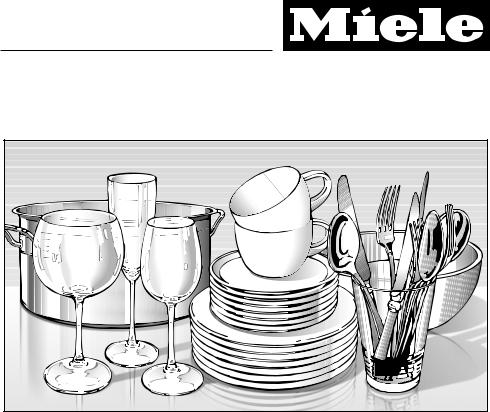
Operating Instructions
Dishwasher
G 5770
G 5775
To prevent accidents and appliance damage read these instructions before
en - US
installation or use. |
M.-Nr. 07 909 250 |

Contents
IMPORTANT SAFETY INSTRUCTIONS. . . . . . . . . . . . . . . . . . . . . . . . . . . . . . . . . 4
Guide to the dishwasher . . . . . . . . . . . . . . . . . . . . . . . . . . . . . . . . . . . . . . . . . . . . 8 Control panel . . . . . . . . . . . . . . . . . . . . . . . . . . . . . . . . . . . . . . . . . . . . . . . . . . . . . . 9
Caring for the environment . . . . . . . . . . . . . . . . . . . . . . . . . . . . . . . . . . . . . . . . . 10
Before using for the first time. . . . . . . . . . . . . . . . . . . . . . . . . . . . . . . . . . . . . . . 11 To open the door . . . . . . . . . . . . . . . . . . . . . . . . . . . . . . . . . . . . . . . . . . . . . . . . . . 11 Display . . . . . . . . . . . . . . . . . . . . . . . . . . . . . . . . . . . . . . . . . . . . . . . . . . . . . . . . . . 12 Filling the salt container . . . . . . . . . . . . . . . . . . . . . . . . . . . . . . . . . . . . . . . . . . . . . 14 Refill salt message . . . . . . . . . . . . . . . . . . . . . . . . . . . . . . . . . . . . . . . . . . . . . . . . . 15 Rinse aid . . . . . . . . . . . . . . . . . . . . . . . . . . . . . . . . . . . . . . . . . . . . . . . . . . . . . . . . 16 Adding rinse aid . . . . . . . . . . . . . . . . . . . . . . . . . . . . . . . . . . . . . . . . . . . . . . . . . . 16 Rinse aid indicator . . . . . . . . . . . . . . . . . . . . . . . . . . . . . . . . . . . . . . . . . . . . . . . . . 17
Loading the dishwasher . . . . . . . . . . . . . . . . . . . . . . . . . . . . . . . . . . . . . . . . . . . 18 Items not recommended for dishwashing . . . . . . . . . . . . . . . . . . . . . . . . . . . . . . . 19 Typical load for 10 place settings . . . . . . . . . . . . . . . . . . . . . . . . . . . . . . . . . . . . . 20 Typical load for 16 place settings . . . . . . . . . . . . . . . . . . . . . . . . . . . . . . . . . . . . . 21 Upper basket . . . . . . . . . . . . . . . . . . . . . . . . . . . . . . . . . . . . . . . . . . . . . . . . . . . . . 22 Lower basket . . . . . . . . . . . . . . . . . . . . . . . . . . . . . . . . . . . . . . . . . . . . . . . . . . . . . 26 Cutlery . . . . . . . . . . . . . . . . . . . . . . . . . . . . . . . . . . . . . . . . . . . . . . . . . . . . . . . . . . 29
Optional accessories. . . . . . . . . . . . . . . . . . . . . . . . . . . . . . . . . . . . . . . . . . . . . . 31
Use . . . . . . . . . . . . . . . . . . . . . . . . . . . . . . . . . . . . . . . . . . . . . . . . . . . . . . . . . . . . 32 Adding detergent. . . . . . . . . . . . . . . . . . . . . . . . . . . . . . . . . . . . . . . . . . . . . . . . . . 33 Turning on . . . . . . . . . . . . . . . . . . . . . . . . . . . . . . . . . . . . . . . . . . . . . . . . . . . . . . . 34 Selecting a program . . . . . . . . . . . . . . . . . . . . . . . . . . . . . . . . . . . . . . . . . . . . . . . 34 Starting a program . . . . . . . . . . . . . . . . . . . . . . . . . . . . . . . . . . . . . . . . . . . . . . . . . 34
Program Guide . . . . . . . . . . . . . . . . . . . . . . . . . . . . . . . . . . . . . . . . . . . . . . . . . . . 35
Use . . . . . . . . . . . . . . . . . . . . . . . . . . . . . . . . . . . . . . . . . . . . . . . . . . . . . . . . . . . . 36 Time display. . . . . . . . . . . . . . . . . . . . . . . . . . . . . . . . . . . . . . . . . . . . . . . . . . . . . . 36 Standby . . . . . . . . . . . . . . . . . . . . . . . . . . . . . . . . . . . . . . . . . . . . . . . . . . . . . . . . . 36 At the end of a program. . . . . . . . . . . . . . . . . . . . . . . . . . . . . . . . . . . . . . . . . . . . . 37 Preparing your appliance for an extended vacation . . . . . . . . . . . . . . . . . . . . . . . 37 Interrupting a program. . . . . . . . . . . . . . . . . . . . . . . . . . . . . . . . . . . . . . . . . . . . . . 38 Changing a program . . . . . . . . . . . . . . . . . . . . . . . . . . . . . . . . . . . . . . . . . . . . . . . 38
Additional options . . . . . . . . . . . . . . . . . . . . . . . . . . . . . . . . . . . . . . . . . . . . . . . . 39 Intensive lower basket . . . . . . . . . . . . . . . . . . . . . . . . . . . . . . . . . . . . . . . . . . . . . . 39 Turbo . . . . . . . . . . . . . . . . . . . . . . . . . . . . . . . . . . . . . . . . . . . . . . . . . . . . . . . . . . . 39 Delay start . . . . . . . . . . . . . . . . . . . . . . . . . . . . . . . . . . . . . . . . . . . . . . . . . . . . . . . 40
2

Contents
Settings menu . . . . . . . . . . . . . . . . . . . . . . . . . . . . . . . . . . . . . . . . . . . . . . . . . . . 42 Opening the "Settings" menu . . . . . . . . . . . . . . . . . . . . . . . . . . . . . . . . . . . . . . . . . 42 Water hardness . . . . . . . . . . . . . . . . . . . . . . . . . . . . . . . . . . . . . . . . . . . . . . . . . . . 43 Buzzer . . . . . . . . . . . . . . . . . . . . . . . . . . . . . . . . . . . . . . . . . . . . . . . . . . . . . . . . . . 44 Drying Plus. . . . . . . . . . . . . . . . . . . . . . . . . . . . . . . . . . . . . . . . . . . . . . . . . . . . . . . 45 Optimize standby. . . . . . . . . . . . . . . . . . . . . . . . . . . . . . . . . . . . . . . . . . . . . . . . . . 45 Brightness . . . . . . . . . . . . . . . . . . . . . . . . . . . . . . . . . . . . . . . . . . . . . . . . . . . . . . . 46 Factory default . . . . . . . . . . . . . . . . . . . . . . . . . . . . . . . . . . . . . . . . . . . . . . . . . . . . 47 Leaving the Settings menu . . . . . . . . . . . . . . . . . . . . . . . . . . . . . . . . . . . . . . . . . . 47
Frequently Asked Questions . . . . . . . . . . . . . . . . . . . . . . . . . . . . . . . . . . . . . . . 48 Technical faults . . . . . . . . . . . . . . . . . . . . . . . . . . . . . . . . . . . . . . . . . . . . . . . . . . . 48 Faults in the water intake/water drain . . . . . . . . . . . . . . . . . . . . . . . . . . . . . . . . . . 49 General problems with the dishwasher . . . . . . . . . . . . . . . . . . . . . . . . . . . . . . . . . 50 Sounds. . . . . . . . . . . . . . . . . . . . . . . . . . . . . . . . . . . . . . . . . . . . . . . . . . . . . . . . . . 51 Poor cleaning results . . . . . . . . . . . . . . . . . . . . . . . . . . . . . . . . . . . . . . . . . . . . . . . 52
After sales service . . . . . . . . . . . . . . . . . . . . . . . . . . . . . . . . . . . . . . . . . . . . . . . . 55
Transport . . . . . . . . . . . . . . . . . . . . . . . . . . . . . . . . . . . . . . . . . . . . . . . . . . . . . . . 56
User Maintenance Instructions. . . . . . . . . . . . . . . . . . . . . . . . . . . . . . . . . . . . . . 57
Cleaning and Care . . . . . . . . . . . . . . . . . . . . . . . . . . . . . . . . . . . . . . . . . . . . . . . . 58 Triple filter system . . . . . . . . . . . . . . . . . . . . . . . . . . . . . . . . . . . . . . . . . . . . . . . . . 60 Cleaning the drain pump and non-return valve . . . . . . . . . . . . . . . . . . . . . . . . . . . 63
Installation instructions . . . . . . . . . . . . . . . . . . . . . . . . . . . . . . . . . . . . . . . . . . . 65
Help to protect the environment. . . . . . . . . . . . . . . . . . . . . . . . . . . . . . . . . . . . . 66
Electrical connection. . . . . . . . . . . . . . . . . . . . . . . . . . . . . . . . . . . . . . . . . . . . . . 67
Plumbing. . . . . . . . . . . . . . . . . . . . . . . . . . . . . . . . . . . . . . . . . . . . . . . . . . . . . . . . 69 Connection to the water supply . . . . . . . . . . . . . . . . . . . . . . . . . . . . . . . . . . . . . . . . 69 Drainage . . . . . . . . . . . . . . . . . . . . . . . . . . . . . . . . . . . . . . . . . . . . . . . . . . . . . . . . 70
3
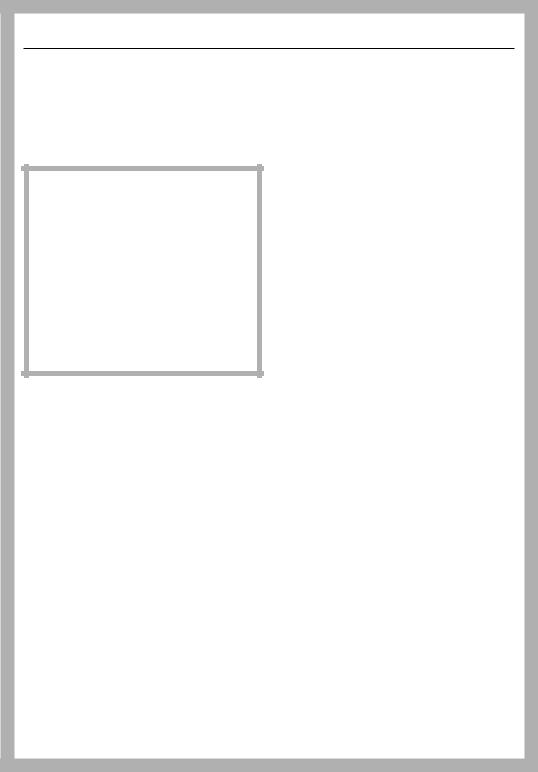
IMPORTANT SAFETY INSTRUCTIONS
WARNING –
When using your dishwasher, follow basic precautions, including the following:
Read all instructions before installation or use of the dishwasher to prevent injury and machine damage.
Use the dishwasher only for its intended purpose. This appliance is intended for residential use only.
Keep these operating instructions in a safe place and pass them on to any future user.
Electrical Safety
Before installation, make sure that the voltage and frequency listed on the data plate correspond with the household electrical supply. This data must correspond to prevent injury and machine damage. Consult a qualified electrician if in doubt.
Before installation or service, disconnect the power supply to the work area by unplugging the unit, "tripping" the circuit breaker or removing the fuse.
Do not use an extension cord to connect this appliance to electricity. Extension cords do not guarantee the required safety of the appliance (e.g. danger of overheating).
Correct usage
The dishwasher is not designed for commercial use. It is intended for use in domestic households and in similar working and residential environments such as, shops, offices and showrooms or guest houses.
The dishwasher is not intended for outdoor use.
It must only be used as a domestic appliance as specified in these operating instructions, for cleaning domestic crockery and cutlery. Any other usage is not supported by the manufacturer and could be dangerous.
Persons who lack physical, sensory or mental abilities, or experience with the appliance should not use the dishwasher without supervision or instruction by a responsible person.
Be certain your appliance is properly installed and grounded by a qualified technician. To guarantee the electrical safety of this appliance continuity must exist between the appliance and an effective grounding system. It is imperative that this basic safety requirement be met. If there is any doubt, have the electrical system of the house checked by a qualified electrician.
If the supplied power cord is damaged it must only be replaced by a Miele Service technician with a genuine Miele power cord.
The outlet must be accessible at all times after installation to disconnect the dishwasher.
4

IMPORTANT SAFETY INSTRUCTIONS
Installation
The dishwasher must be installed and connected in accordance with the installation instructions.
Installation and repair work should be performed by a Miele authorized service technician. Work by unqualified persons could be dangerous and may void the warranty.
Do not install or use a damaged dishwasher. A damaged appliance is dangerous. Unplug the machine and contact Miele Technical Service Department.
Ensure that any plastic wrappings, bags, etc. are disposed of safely and kept out of the reach of children.
Danger of suffocation!
This appliance must not be used in a non-stationary location (e.g. on a boat).
WARNING - Fire hazard!
Do not cover or crush the plug of the appliance. Ensure that the cabinet opening for the dishwasher provides ample space for the plug and cord. Installing the dishwasher in a tight space may crimp the power cord or put pressure on the plug which could cause overheating.
This dishwasher should only be installed under a continuous counter top secured to adjacent cabinetry.
Do not install this dishwasher beneath a cooking surface, oven or any appliance that radiates heat.
High temperatures from these units may damage the dishwasher.
A toe-kick must be used with the dishwasher. If the supplied toe-kick is not used, a cabinet matching toe-kick must be installed.
Do not install the dishwasher in an area where it will be exposed to temperatures below freezing.
Do not cut the intake hose or submerge it in liquid. This hose contains electrical components that could cause injury or property damage if cut or submerged.
Only power up the dishwasher when all installation and plumbing work is complete.
5

IMPORTANT SAFETY INSTRUCTIONS
Use
To reduce the risk of injury, do not allow children to play in, on or near the dishwasher. It is possible for small fingers may be pinched in the door.
Only use the dishwasher if all panels are properly in place.
Do not tamper with the controls.
Do not sit or stand on the door or baskets of the dishwasher. Close the door when not in use.
Under certain conditions, hydrogen gas may be produced in a hot water system that has not been used for two weeks or more. HYDROGEN GAS IS EXPLOSIVE. If the hot water system has not been used for such a period, turn on all hot water faucets and let water flow from each for several minutes before using the dishwasher. This will release any accumulated hydrogen gas. Do not smoke or use an open flame during this time.
Be sure that all items placed in the dishwasher are "dishwasher safe". For items not labeled, check the manufacturer’s recommendations.
When loading tableware, place sharp items away from the door to prevent damage to the seal. Load sharp items pointing downwards to prevent injuries.
Only use detergents and rinse aids recommended for residential dishwashers. Keep all detergents and rinse aids out of the reach of children.
Do not inhale or swallow detergents. Dishwasher detergents contain irritant and corrosive ingredients. They can cause burning in the mouth and throat if swallowed, or inhibit breathing. Consult a doctor immediately if detergent has been swallowed or inhaled.
Do not drink water from the dishwasher! Harmful residues could be present.
Do not fill the rinse aid reservoir or salt container with detergent. It will destroy the rinse aid compartment and water softener.
If the supplied power cord is damaged it must only be replaced by a Miele Service technician with a genuine Miele power cord.
The outlet must be accessible at all times after installation to disconnect the dishwasher.
6

IMPORTANT SAFETY INSTRUCTIONS
This model offers a Drying Plus feature, i.e. the door will automatically open, without an audible signal first being given, at the end of the program releasing warm air from the dishwasher. Use caution, the air may be hot!
Advise the user of the Drying Plus feature to avoid injuries by walking, bumping or knocking into the partially opened door.
Dishes can be very hot at the end of a program. Allow the dishes to cool until they are cool enough to handle before unloading them.
The water supply must be turned off when the appliance is not used for a longer period of time (e.g. during vacations).
Disposal of an appliance
If the appliance is removed from its installation site and will not be used, remove the doorlock to the wash cabinet to prevent children from locking themselves in the machine.
SAVE THESE
INSTRUCTIONS
7
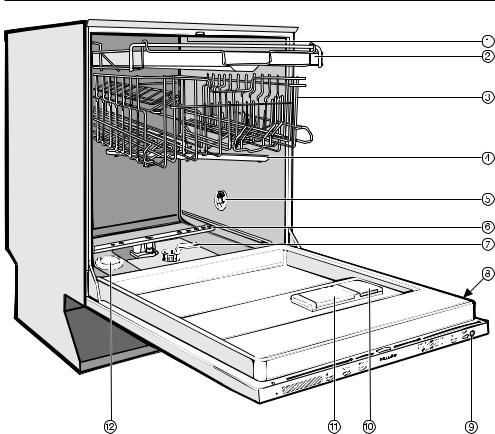
Guide to the dishwasher
Upper spray arm (not visible)
Cutlery tray
Upper basket
Middle spray arm
Air inlet for drying (depending on model)
Lower spray arm
Triple filter system
Data plate
Optical interface
Rinse aid reservoir
Dual compartment detergent dispenser
Salt container
8

Guide to the dishwasher
Control panel
Display
Delay start button with indicator light
Turbo button with indicator light
Intensive lower basket button with indicator light
Program selection
Program selector button
On/Off button with indicator light
Optical Interface (in-operation indicator light)
This operating instruction manual describes several dishwasher models with different indicated settings.
The different dishwasher models are named : Standard = 32 1/16" (81.5 cm) high dishwashers XXL = 33 11/16" (85.5 cm) high dishwashers.
9

Caring for the environment
Energy saving washing
This dishwasher is exceptionally economical in the use of water and electricity. For best results follow these tips:
For lowest energy consumption you may connect the dishwasher to a cold water source.
For fastest possible wash times, with slightly higher energy consumption, connect the dishwasher to a hot water source.
Make full use of the baskets without overloading for the most economical washing.
Use the correct amount of detergent and rinse aid. Detergent dosage is dependent upon the amount of soiling and type of dishware being washed. See the "Program Guide" for more information.
When using powder or gel detergent, reduce the amount to 2/3 of the normal amount when washing a small load.
Choose a program that best suits the degree of soiling and the type of dishes being washed.
10

Before using for the first time
To open the door
The door will open automatically at the end of the program to aid in the drying process.
This function can be deactivated (see "Settings - Drying Plus").
Pull the handle to open the door.
If the door is opened during operation, the rinsing function is automatically canceled.
Keep the opening area free of obstructions.
To close the door
Push the baskets in.
Lift the door and push until the catch engages.
Keep fingers and other body parts away from the door as it is closing. Danger of injury.
11
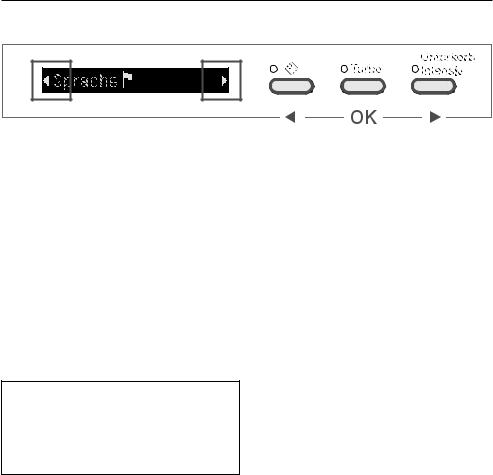
Before using for the first time
Display
The following functions can be selected or set on the display:
–program
–options
–delay start
–settings
While a program is running, the following appears in the display:
–the program segment
–the approximate remaining running time
–any faults or messages
To save energy, the dishwasher turns off a few minutes after a button is pressed.
To turn the dishwasher on again, press the button.
"Settings" menu
You can adjust the dishwasher's electronics to suit various requirements in the "Settings" menu.
You can access the Settings menu by pressing a specific button combination.
You can find more detailed information in the Settings section.
The actual function of the buttons next to the display is switched off in the Settings menu, allowing you to select and confirm menu items using these buttons.
The left and right arrows in the display indicate that additional selections are available. You can choose these selections using the left or right button next to the display.
Use the center button next to the display to confirm messages or settings and change to the next menu or another menu level.
A check will appear beside the currently selected setting.
12

Before using for the first time
Press the button to turn the dishwasher on.
A Welcome screen shows when the dishwasher is turned on for the first time.
Language
The display changes automatically to the language setting.
Select the desired language and confirm with the center button.
The selected language set is marked with a check.
Water hardness
The display changes to the water hardness setting.
To achieve good cleaning results, the dishwasher needs soft water. Hard water results in calcium deposits on dishware and in the dishwasher.
If your tap water hardness is above 4 °d (4 gr/gal [US]), the water should be softened.
–Your local water authority will be able to advise you of the water hardness level in your area.
–The dishwasher must be programmed to correspond to the water hardness in your area.
–In areas where the water hardness fluctuates (e. g. 37 - 50 °d
[39 -52 gr/gal]) always program the machine to the higher value (in this example 50 °d [52 gr/gal]).
If there is a fault, it will help the service technician to know the hardness of your local water supply.
Please note your water hardness below:
°d (gr/gal)
The water hardness was programmed at 1 °d (1 gr/gal) by factory default.
Select the hardness of your water supply and confirm with the center button.
See "Settings - Water hardness" for more information.
Two notes appear in the display.
After confirming these notes, Add
rinse aid and/or Add salt may
appear in the display.
Confirm these notes. The display changes to the Main menu.
These basic settings are saved after the first full program cycle is completed.
13

Before using for the first time
Every dishwasher is tested before leaving the factory. Any water remaining in the machine is from the final factory test and does not indicate that the machine has been used.
Remove the lower basket from the wash cabinet and unscrew the salt container lid.
When opening the salt container, water will run out. Open the container only to refill salt.
Filling the salt container
To achieve good cleaning results, the dishwasher needs soft water (water that is low in minerals). Hard water results in calcium deposits on dishware and in the dishwasher.
Therefore, if your tap water hardness is above 4 °d (4 gr/gal) the water should be softened. The built-in water softener is designed for this purpose. The water softener is suitable for a water hardness up to 70 °d (73 gr/gal).
Inadvertently filling the salt container with dishwashing detergent (including liquid detergent) will damage the water softener.
Only use water softener salt specially formulated for dishwashers. Other salts may contain insoluble additives which can impair the water softener.
If using "Tab" products which include salt, still add salt to the machine to achieve optimal cleaning results and ensure long-term functioning of the water softener.
Important: The salt container must be filled with 2 quarts (2 l) of water before adding salt for the first time so the salt can dissolve
properly. Water does not have to be added with subsequent refills.
14
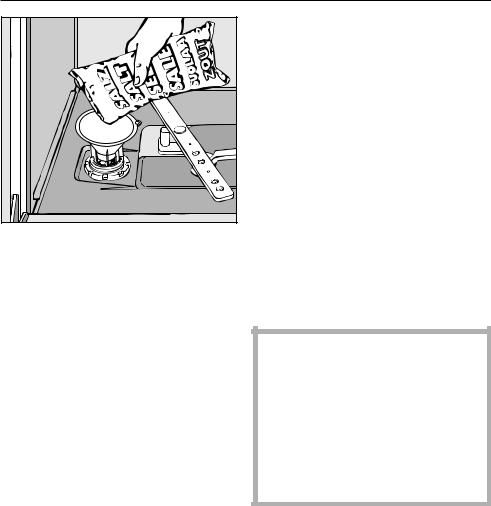
Before using for the first time
Place the provided funnel over the salt container and carefully fill it with salt. The salt container holds approx. 4.4 lbs (2 kg) of salt, depending on the type of salt.
Clean any excess salt from the threads of the container opening. Screw the lid on firmly.
Immediately after each refill, run the "Rinse & Hold" program without a load. This will remove any traces of salt from inside the wash cabinet.
Refill salt message
As soon as the Insufficient salt
message is displayed, refill the salt container
Confirm with the center button.
The "Insufficient salt" message goes out.
If a sufficiently high concentration of salt has not yet formed, the Insufficient salt message may continue to be displayed after adding the salt. In this case, confirm again with the center button.
The Insufficient salt message is turned off if you have programmed the dishwasher to a water hardness below 4 °d (4 gr/gal).
If using"Tab" detergent products in your dishwasher, the messages can be turned off if desired (see "Settings - Deactivate indicators").
If you switch to using detergent that does not contain salt or rinse aid, it is important to remember to replenish the salt and rinse aid and to turn the indicators back on.
15
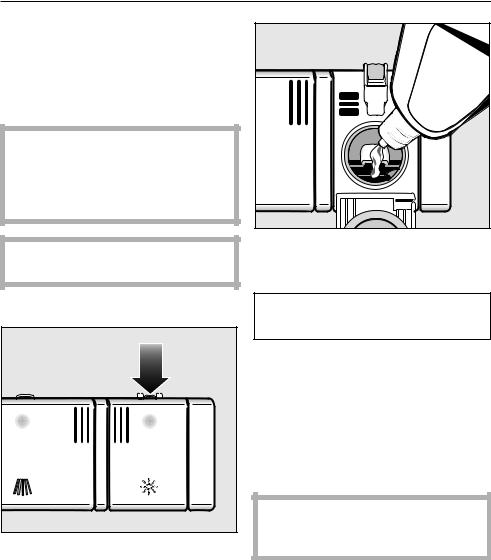
Before using for the first time
Rinse aid
Rinse aid helps to prevent spotting on dishes and glassware.
The rinse aid is filled in the reservoir and the set amount will be automatically dosed.
Filling the rinse aid reservoir with detergent (liquid or powder) will damage the reservoir. Only pour rinse aid formulated for residential dishwashers into the reservoir.
When using "Tab" detergents rinse aid is not needed.
Adding rinse aid
Press the button on the rinse aid reservoir in the direction of the arrow until the flap springs open.
Pour liquid rinse aid into the reservoir until it is visible on the surface of the screen.
The rinse aid reservoir holds approximately 3.7 fl. oz. (110 ml).
Press on the flap until you hear it click shut. Failure to close it all the way allows water to enter the reservoir during the wash program.
Clean any spilled rinse aid. This prevents over-foaming occurring during the next program.
You can adjust the rinse aid dosage for best results (see "Settings - Rinse aid").
16

Before using for the first time
Rinse aid indicator
When the Refill rinse aid message appears, the reservoir contains sufficient rinse aid for 2 - 3 programs only.
Add rinse aid once the program has finished.
Confirm with the center button.
The "Refill rinse aid" message will go out.
If using "Tab" detergent products in your dishwasher, the messages can be turned off if desired (see "Settings - Deactivate indicators").
If you switch to using detergent that does not contain salt or rinse aid, it is important to remember to replenish the salt and rinse aid and to turn the indicators back on.
17

Loading the dishwasher
Do not wash items soiled with ash, sand, wax, grease or paint in the dishwasher.
Ash and sand do not dissolve and will be distributed throughout the inside of the dishwasher.
Wax, grease and paint will cause permanent discoloration and damage to the dishwasher.
Scrape food from dishes before placing them in the dishwasher, rinsing is not necessary.
Some foods contain natural dyes, e.g. carrots or tomatoes. Plastic items may discolor permanently if they come in contact with food dyes.
All items can be placed anywhere in the baskets.
Load dishes so that water can reach all surfaces. Do not place dishes or cutlery inside other pieces.
Make sure that all items are securely positioned.
Hollow items such as cups and glasses should be placed upside down in the baskets.
To ensure good water coverage, tall, narrow and hollow items, i.e. vases or champagne glasses, should be placed in the center of the basket rather than in the corners.
Concave based items such as mugs or bowls, should be placed at an angle so that water does not pool.
The spray arms must not be blocked by items that are too tall or hang through the baskets. Check clearance by manually rotating the spray arms.
Place very small items in the cutlery tray or basket so they do not fall to the bottom of the wash cabinet.
Food residue and spilled liquids should be cleaned from the sides of the dishwasher door. These are outside of the wash cabinet and are not cleaned by water from the spray arms.
18

Loading the dishwasher
Items not recommended for dishwashing
–Cutlery with wooden handles
–Wooden cutting boards
–Glued items such as old knives with handles glued together around the shank of the blade
–Handmade craft items, antique, metal trimmed or decorative glassware
–Plastic items that are not heat resistant
–Copper, brass, tin or aluminum
–Dishes with color painted over the glaze. These dishes may fade over time
–Fine glassware and crystal items should only be washed using the "China & Crystal" program*.
Otherwise clouding or etching may occur after frequent washing.
–Cast iron pots and pans
* depending on model
If unsure whether your china and crystal are dishwasher safe, please check with the manufacturer. The China & Crystal program, although extremely gentle and thorough can cause the china and crystal to "wear" if they are not dishwasher safe.
Glassware:
–There are no standard guidelines for washing glassware, when in doubt wash by hand.
–When purchasing new dishes, glasses and cutlery, make sure they are dishwasher safe. Only wash items marked "dishwasher safe" in the dishwasher.
–If fine glassware is washed in the dishwasher select the "China & Crystal" program*. This will reduce the risk of clouding.
Silver and aluminum:
–Silver or aluminum items may tarnish.
–Silverware previously cleaned with a silver polish may be damp or spotted at the end of a program where water has adhered to the polish. This can be rubbed off with a soft, dry cloth. Silver that has been cleaned in an immersion dip is usually dry at the end of a program, but may tarnish.
–If left to dry, foods containing sulfur can discolor silver. These include egg yolk, onions, mayonnaise, mustard, fish and marinades.
–Silverware may tarnish or pit if washed next to stainless steel. Leave space between these metals.
–Clean aluminum items, e.g. grease filters, with domestic dishwasher detergent only.
19
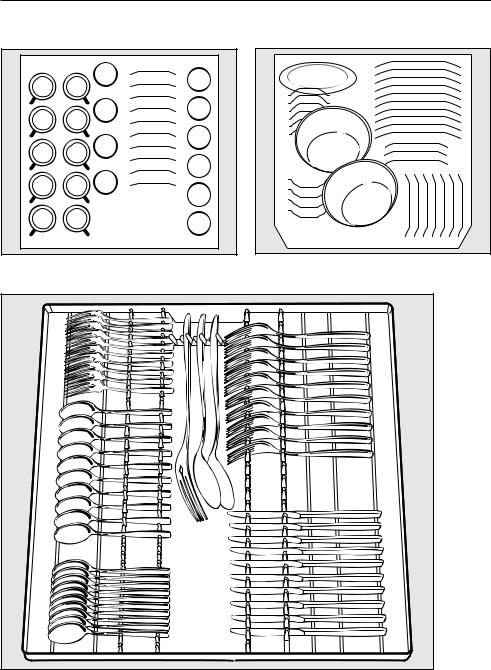
Loading the dishwasher
Typical load for 10 place settings
Upper basket |
Lower basket |
Cutlery tray
20
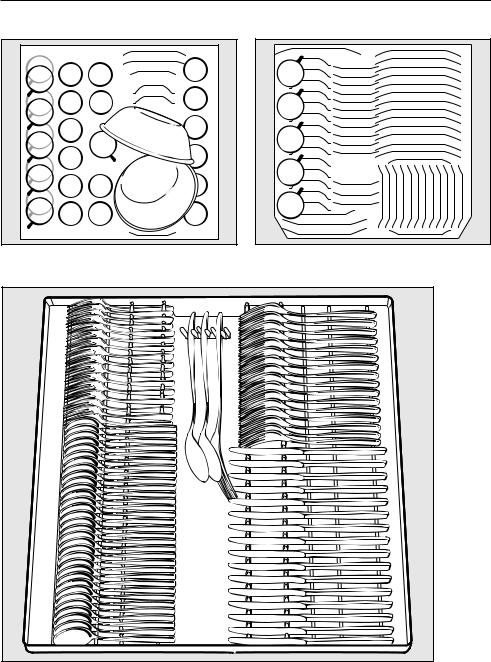
Loading the dishwasher
Typical load for 16 place settings
Upper basket |
Lower basket |
Cutlery tray
21
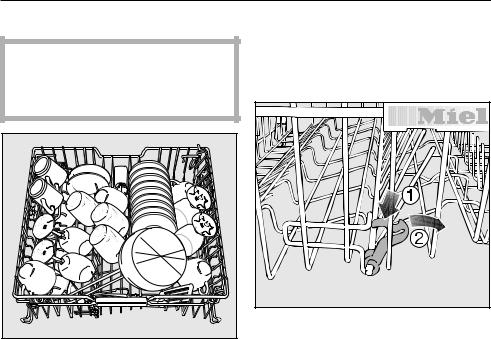
Loading the dishwasher
Upper basket |
Foldable spikes |
Always use the dishwasher with the upper and lower basket inserted (except during the Tall items program, if available).
Load the upper basket with small, lightweight, or delicate items such as cups, saucers, glasses, dessert bowls, etc.
Shallow pans can also be placed in the upper basket.
Long items such as soup ladles, mixing spoons and long knives should be placed lying down across the front of the upper basket.
The rows of spikes can be lowered to make more room for larger items, such as casserole dishes.
Press the yellow lever down and fold down the spikes .
Hinged cup rack
To make room for tall items, raise the rack upwards.
Glasses can be arranged along the cup rack to give them some support during the program.
Lower the cup rack and lean the glasses against it.
22
